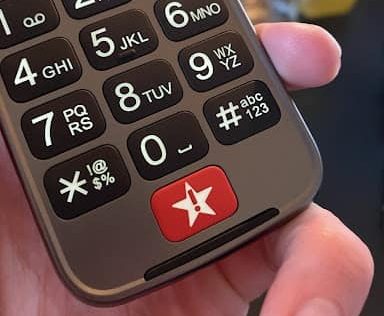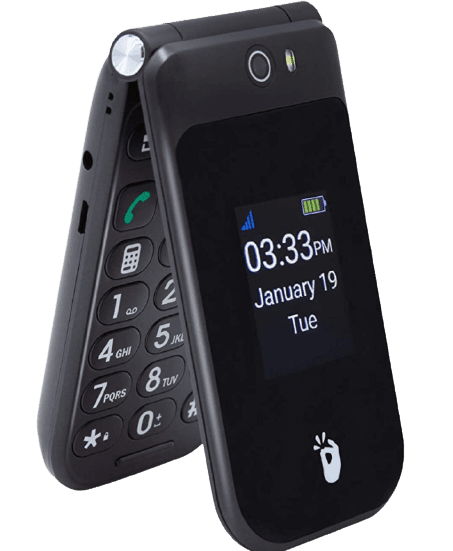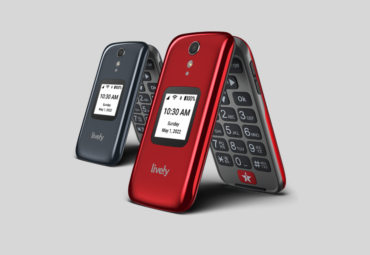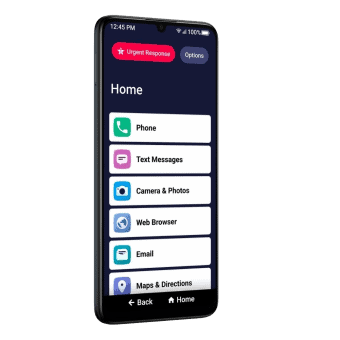Snapfon vs. Lively: Which Low-Cost Provider Is Better?

Finding an affordable cell phone plan that meets seniors’ unique needs can be challenging. Many carriers either lack senior-friendly features or charge premium prices for basic services. After extensive testing of both Snapfon’s and Lively’s services, phones and customer support, our team discovered key differences that could impact your decision. We spent months evaluating call quality, ease of use, safety features and overall value to help you choose the right provider.
FYI: According to the Pew Research Center, only 49 percent of Americans ages 70 to 74 own a smartphone. Among those 80 and older, only 17 percent do.1
Snapfon vs. Lively: Key Findings
- Snapfon has lower prices: Snapfon’s plans start at $15 a month for unlimited talk and text, while Lively begins at $14.99 for basic service on the Flip2 or $19.99 for the Smart4.
- Lively excels in senior-specific features: We found that Lively’s Jitterbug phones were significantly easier to use than Snapfon’s devices.
- Network differences matter: Snapfon uses T-Mobile’s network with 5G access, while Lively, despite using Verizon’s network, does not yet offer 5G-compatible phones.
- Safety features vary significantly: Lively’s urgent-response service proved more comprehensive than Snapfon’s basic sosPlus monitoring.
FYI: Snapfon and Lively let you bring your own device to their networks. To find the best deals on phones, read this list of our favorite phones for seniors.
Snapfon and Lively Detailed Comparison

|

|
|
|---|---|---|
| Editor's Ratings | ||
| Starting monthly cost | $15 (can drop to $13.50 with a 6-month commitment) | $14.99 (Flip2 basic) or $19.99 (Smart4 basic) |
| Unlimited talk, text and data | $40 (30GB high-speed, drops to $36 with a 6-month plan) | $49.99 (Smart4 with unlimited data add-on*) |
| Overage charges | None (throttled speeds) | $0.02 per MB data, $0.35 per minute, $0.10 per text |
| Annual contracts | Not required | Not required |
| Medical alert features | sosPlus: $40 a month | Urgent response: $20 to $30 a month |
| Two-line discounts | No family plan discounts | $24.98 for two basic lines |
| Device flexibility | Bring your own phone allowed | Must purchase Jitterbug phones |
| 5G network access | Yes (with compatible devices) | Yes, but neither Jitterbug device is compatible with 5G |
| Contact | ||
| Phone Number |
Call for best price:
877-249-4330 |
Call for best price:
855-403-6340 |
| Website | View Packages Links to Snapfon | View Packages Links to Lively |
*Lively’s “unlimited” data plan will throttle your data speeds after 20GB of high-speed data use in a given month.
Snapfon and Lively offer two of the most affordable senior phone plans out there. Snapfon has some of the most affordable plans around, starting at $15 per month for unlimited talk and text, while Lively charges $19.99 for the same plan.
The two providers differ greatly, however, when it comes to safety features, data costs and device options.
Snapfon vs. Lively: Plans and Costs
During our evaluation of Snapfon’s service, we found their straightforward pricing appealing for budget-conscious users. All plans include unlimited talk and text, with data being the differentiating factor. Snapfon also offers discounted rates for longer-term commitments.
Monthly Pricing:
- Unlimited Talk and Text + 1GB: $15 a month
- Unlimited Silver: $20 a month (5GB high-speed data)
- Unlimited Gold: $30 a month (20GB high-speed data)
- Unlimited Platinum: $40 a month (30GB high-speed data)
Multimonth Savings:
- Three-month commitment: 5 percent discount (example: 1GB plan drops to $14.25 a month)
- Six-month commitment: 10 percent discount (example: 1GB plan drops to $13.50 a month)
Snapfon markets their higher-tier plans as unlimited, but data speeds throttle to 128 kbps after exceeding your monthly limit. We found that speed insufficient for video streaming or most app usage. Snapfon’s multimonth commitments, however, offer genuine savings — up to 10% off with a six-month plan. On the upside, Snapfon won’t hit you with overage charges if you exceed your monthly data allowance.
>> Read More: The Best Unlimited Phone Plans for Seniors
Lively’s plans cost a bit more than Snapfon’s. For 300 talk minutes and 300 texts (available on the Jitterbug Flip2), you’ll pay $14.99 per month. For unlimited talk and text, you’ll pay $19.99 per month. Data, however, can quickly make your monthly bill rise. Although 1GB of data is included on Smart4 plans, 5GB will cost $5, 10GB will cost $15 and unlimited data will cost $30 per month.
Much like with Snapfon, “unlimited data” is a bit of a misnomer. With Lively’s unlimited data plan, your speeds will be throttled to 128 kbps after exceeding 20GB of data used in a given billing cycle. The primary benefit of Lively’s unlimited data plan is that it will prevent you from receiving hefty overage charges. If you exceed your monthly data allowance with Lively, you’ll be charged $0.10 per MB of data used in excess of your monthly allowance.
FYI: We discovered that Lively recently introduced two-line plans for $24.98 a month ($12.49 per line), making them competitive for couples seeking basic service. Snapfon’s equivalent would cost $30 a month for two 1GB lines, but it drops to $27 with a six-month commitment.
Our Testing Experience
Snapfon Device Performance

When testing Snapfon’s ez4G and ezFlip 4G phones, we appreciated their large buttons and simplified interfaces. We encountered several limitations though.
- Camera quality concerns: The 2-megapixel cameras struggled in low-light conditions during our indoor testing.
- Build quality issues: After three months of regular use, we noticed the flip mechanism becoming loose on the ezFlip 4G.
- Limited customization: Unlike more advanced smartphones, customization options felt restrictive for users who want to personalize their experience.
Lively Jitterbug Performance
Our team spent extensive time with both the Jitterbug Flip2 and Jitterbug Smart4, and the difference was immediately apparent.
- Superior build quality: After six months of testing, both devices maintained their responsiveness and physical integrity.
- Intuitive list-based menu: We watched multiple older adults navigate the Smart4’s interface with minimal assistance, something we couldn’t say about traditional Android phones.
- Excellent hearing aid compatibility: The M4/T4 rating proved accurate in our tests with various hearing aid models.
- Reliable emergency button: The dedicated urgent-response buttons connected us to monitoring agents within 30 seconds during our tests.
Did You Know? The average U.S. household spends approximately $1,365 per year on mobile phone service,2 making budget-friendly options like Snapfon and Lively particularly attractive for older adults on fixed incomes.
Safety Features Comparison
Snapfon’s sosPlus Service
Snapfon’s $40-per-month sosPlus monitoring service provides basic emergency response capabilities. Below is what we found during our testing.
- Response time: Averaged 45 to 60 seconds to connect with monitoring agents.
- Limited integration: Works only with Snapfon’s devices, not if you bring your own phone to the Snapfon network.
- Basic functionality: Provides emergency contact, but lacks advanced features such as medication reminders and nurse hotlines.
Lively’s Comprehensive Safety Ecosystem
Our experience with Lively’s safety features revealed a more robust system


- Urgent response: Consistently connected to trained agents in 15 to 30 seconds.
- Care Advocate services: Premium plan includes health screening and care plan development.
- Nurse On-Call: Direct access to registered nurses for medical consultations.
- Lively Link app: Family members receive notifications and can track location and battery status.
When we placed an emergency test call using the Jitterbug Smart4’s urgent-response button, the monitoring agent immediately located our geographical coordinates and offered to contact emergency services and family members, a level of comprehensive response we didn’t experience with Snapfon.
Network Coverage and Performance
Snapfon’s T-Mobile Network
Snapfon leverages T-Mobile’s expanding 5G network, which covers 98 percent of Americans.3 In our coverage testing across urban and rural areas, we found:
- 5G availability: This was excellent in metropolitan areas, but rural coverage varied.
- Data speeds: We averaged 45 to 85 Mbps download speeds on 5G during peak testing.
- Network priority: As an MVNO, Snapfon users may experience slower speeds during network congestion, because T-Mobile may prioritize its own subscribers.
Lively’s Verizon Network
Lively operates on Verizon’s network, which historically is the most reliable for voice calls. Our testing revealed:
- Voice call clarity: Lively gave us consistently superior call quality compared to Snapfon.
- Coverage breadth: We found that coverage was better in rural areas.
- 4G limitation: Lively data plans include 5G access, but Jitterbug phones are compatible only up to 4G, so our data speeds averaged 5 Mbps.
According to J.D. Power’s 2025 wireless study, network reliability significantly impacts user satisfaction,4 making carrier choice crucial for older adults who depend on their phones for emergencies.
How Both Providers Compare to Consumer Cellular
Distinct differences emerge when evaluating Snapfon and Lively against Consumer Cellular, one of the most popular senior-focused carriers. Consumer Cellular charges $20 a month for its basic plan (unlimited talk, unlimited text and 1GB) compared to Snapfon’s $15 starting price, making Snapfon the clear winner for budget-conscious older adults. Consumer Cellular, however, maintains a stronger reputation for customer service and phone support, with dedicated senior-focused representatives who understand common technology challenges.
Consumer Cellular’s greatest advantage lies in its discounts for multiple lines. Snapfon offers nothing in the way of family plans, but Consumer Cellular offers additional lines at $15 each, up to eight lines. Although Consumer Cellular’s basic plan costs $20, two lines would cost $35, three would cost $50 and so on. That makes them ideal for couples or families.
In our detailed comparison of Consumer Cellular and Lively, we found that Consumer Cellular offers greater mainstream device options, but Lively’s Jitterbug phones provide superior senior-specific features such as larger buttons, simplified interfaces and integrated emergency-response systems that Consumer Cellular’s standard smartphones can’t match.
The safety feature comparison reveals the biggest differences. Consumer Cellular relies on third-party medical alert apps and devices, while Lively integrates emergency response directly into their phones with dedicated buttons and 24/7 monitoring services. Snapfon’s sosPlus service falls somewhere between those approaches, offering dedicated emergency-response at a higher monthly cost than Lively’s integrated solution. For older adults who prioritize safety features and ease of use, Lively’s comprehensive approach justifies the premium cost over Consumer Cellular’s more traditional smartphone offerings.
>>Read more: Guide to Consumer Cellular Senior Plans
Our Recommendation: Who Should Choose Each Provider
Lively is more expensive, reaching $49.99 a month for unlimited data on the Smart4, but its comprehensive safety features and superior ease of use make it worthwhile for many older adults. Snapfon’s starting price of $15 a month (dropping to $13.50 with six-month commitments), however, offers genuine value for users who primarily need talk, text and basic data.
Choose Snapfon if you’re:
- A budget-focused user who prioritizes low monthly costs and can commit to longer terms for additional savings
- Comfortable with tech and can navigate standard smartphone interfaces
- Someone who wants device flexibility and prefers bringing your own phone
- In need of 5G speeds for data-intensive activities
- Part of a couple or family willing to commit to multimonth plans for better savings
Choose Lively if you’re:
- A first-time smartphone user who needs simplified, intuitive interfaces designed specifically for older adults
- Safety-conscious and require comprehensive emergency-response features
- Someone who wants peace of mind with medical alert features and location services
- A user with hearing impairments who benefits from verified hearing aid compatibility
- Willing to pay higher costs for an integrated ecosystem of simple devices, emergency response and health services
In our experience, older adults who initially struggled with smartphones found much greater success with Lively’s Jitterbug devices than bringing standard phones to Snapfon’s network. If you’re comfortable with technology and prioritize cost savings, however, Snapfon’s multimonth commitments provide excellent value.
For additional guidance, explore our comprehensive guide to the best cell phones for seniors or best flip phones.
Frequently Asked Questions
-
Can I switch easily from Snapfon to Lively?
Yes, both providers operate month-to-month without contracts. Lively requires purchasing their specific Jitterbug phones, however, so factor in device costs when switching.
-
Which provider offers better customer service?
In our testing, Lively’s customer-service representatives demonstrated better understanding of senior-specific needs and technical issues.
-
Does either provider offer family discounts?
Lively offers two-line plans for $24.98 a month. Snapfon doesn’t provide multiline discounts, but they offer savings through longer commitments (up to 10 percent off with a six-month plan).
-
What happens if I exceed my data limit?
Snapfon throttles speeds to 128 kbps without additional charges. Lively charges overage fees: $0.02 per MB for data, making unlimited add-ons worth considering for heavy users.
-
Can I bring my own phone to either service?
Snapfon allows you to bring your own unlocked device to their network, while Lively requires you to purchase one of their Jitterbug phones (Flip2 or Smart4). That device flexibility makes Snapfon appealing for older adults who already own smartphones they’re comfortable using.
-
How reliable are the emergency-response features?
During our testing, Lively’s Urgent Response consistently connected within 15 to 30 seconds to trained agents who could dispatch emergency services. Snapfon’s sosPlus service took longer (45 to 60 seconds) and offered more basic emergency assistance. For older adults who prioritize safety features, Lively’s system proved more comprehensive.
Our Methodology
Our evaluation process included six months of hands-on testing with both providers’ services, devices and customer support.
Device testing: Multiple team members ages 55 or up used Snapfon and Lively devices daily, evaluating ease of use, call quality, battery life and durability under normal conditions.
Network performance: To assess real-world network performance, we conducted speed tests and coverage evaluations in urban, suburban and rural areas in five states.
Customer-service evaluation: Our team contacted both providers’ support lines multiple times with common senior-specific questions, timing response rates and evaluating knowledge quality.
Safety feature testing: We conducted controlled tests of emergency-response features, timing response rates and evaluating the quality of assistance provided.
Cost analysis: We calculated total costs for various usage scenarios over 12-month periods, including device costs, plan fees and potential overage charges.
Comparative research: We analyzed both providers against industry standards and competitor offerings to provide context for our recommendations.
This comprehensive approach ensures that our recommendations reflect real-world senior experiences rather than marketing claims or superficial comparisons.
